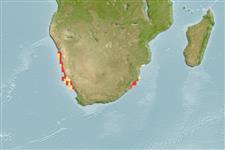>
Eupercaria/misc (Various families in series Eupercaria) >
Sparidae (Porgies)
Etymology: Lithognathus: Greek, lithos = stone + Greek, gnathos = jaw (Ref. 45335).
More on author: Cuvier.
Environment: milieu / climate zone / depth range / distribution range
Ecologia
marino; salmastro benthopelagico; amfidromo (Ref. 51243); distribuzione batimetrica ? - 150 m (Ref. 27121). Subtropical; 22°S - 31°S
Southeast Atlantic: known only from the Orange River mouth to Natal, South Africa.
Length at first maturity / Size / Peso / Age
Maturity: Lm 54.0 range ? - ? cm
Max length : 200 cm TL maschio/sesso non determinato; (Ref. 3198); common length : 65.0 cm TL maschio/sesso non determinato; (Ref. 3507)
Short description
Chiavi di identificazione | Morfologia | Morfometria
Spine dorsali (totale) : 11; Raggi dorsali molli (totale) : 10; Spine anali: 3; Raggi anali molli: 8. Silvery in color, crossbars fade with age.
Found over sandy substrate, in estuaries and oceanic waters. Enters lagoons (Ref. 3198). Feeds bottom invertebrates, including worms, crabs and shrimp (Ref. 27121). Spawns in the sea but uses estuaries as nursery grounds. Prime angling fish. Important food fish. Sold fresh and whole in markets.
Life cycle and mating behavior
Maturità | Riproduzione | Deposizione | Uova | Fecundity | Larve
Bauchot, M.-L. and M.M. Smith, 1984. Sparidae. In W. Fischer and G. Bianchi (eds.) FAO species identification sheets for fishery purposes. Western Indian Ocean (Fishing Area 51). volume 4. [var. pag.] FAO, Rome. (Ref. 3507)
IUCN Red List Status (Ref. 130435: Version 2024-1)
Threat to humans
Harmless
Human uses
Pesca: scarso interesse commerciale; Pesce da pesca sportiva: si
Strumenti
Special reports
Download XML
Fonti Internet
Estimates based on models
Preferred temperature (Ref.
123201): 12.5 - 24.1, mean 15.7 °C (based on 28 cells).
Phylogenetic diversity index (Ref.
82804): PD
50 = 0.5625 [Uniqueness, from 0.5 = low to 2.0 = high].
Bayesian length-weight: a=0.01549 (0.00939 - 0.02556), b=3.04 (2.90 - 3.18), in cm total length, based on LWR estimates for this species & (Sub)family-body (Ref.
93245).
Trophic level (Ref.
69278): 3.1 ±0.1 se; based on diet studies.
Generation time: 10.9 ( na - na) years. Estimated as median ln(3)/K based on 1
growth studies.
Resilienza (Ref.
120179): Basso, tempo minimo di raddoppiamento della popolazione 4.5 - 14 anni (K=0.1).
Fishing Vulnerability (Ref.
59153): High to very high vulnerability (72 of 100).
Climate Vulnerability (Ref.
125649): Very high vulnerability (78 of 100).
Nutrients (Ref.
124155): Calcium = 24.8 [12.9, 45.8] mg/100g; Iron = 0.664 [0.364, 1.136] mg/100g; Protein = 18.5 [16.9, 20.3] %; Omega3 = 0.302 [0.191, 0.497] g/100g; Selenium = 45.7 [21.7, 85.5] μg/100g; VitaminA = 6.95 [2.03, 19.38] μg/100g; Zinc = 0.722 [0.505, 1.031] mg/100g (wet weight);
